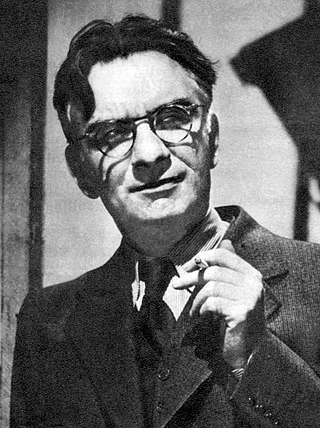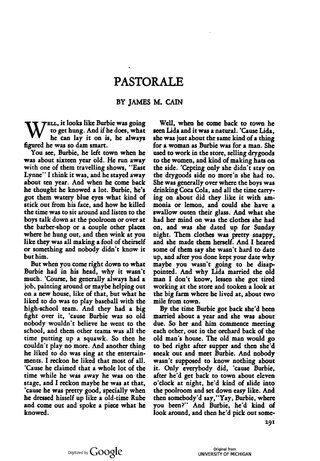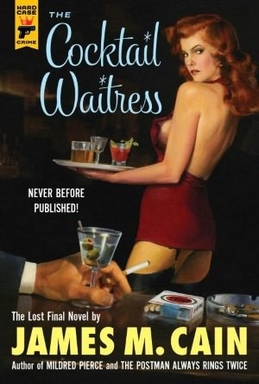
Henry Louis Mencken was an American journalist, essayist, satirist, cultural critic, and scholar of American English. He commented widely on the social scene, literature, music, prominent politicians, and contemporary movements. His satirical reporting on the Scopes Trial, which he dubbed the "Monkey Trial", also gained him attention. The term Menckenian has entered multiple dictionaries to describe anything of or pertaining to Mencken, including his combative rhetorical and prose style.
Mildred Pierce is a psychological drama by James M. Cain published by Alfred A. Knopf in 1941.

James Mallahan Cain was an American novelist, journalist and screenwriter. He is widely regarded as a progenitor of the hardboiled school of American crime fiction.

The Postman Always Rings Twice is a 1934 crime novel by American writer James M. Cain. The novel was successful and notorious upon publication. It is considered one of the most outstanding crime novels of the 20th century. The novel's mix of sexuality and violence was startling in its time and caused it to be banned in Boston.

The American Mercury was an American magazine published from 1924 to 1981. It was founded as the brainchild of H. L. Mencken and drama critic George Jean Nathan. The magazine featured writing by some of the most important writers in the United States through the 1920s and 1930s.

Aileen Pringle was an American stage and film actress during the silent film era.
George Caryl Sims, better known by his pen names Paul Cain and Peter Ruric, was an American pulp fiction author and screenwriter. He is best known for his novel Fast One, which is considered to be a landmark of the pulp fiction genre and was called the "high point in the ultra hard-boiled manner" by Raymond Chandler. Lee Server, author of the Encyclopedia of Pulp Fiction Writers, called Fast One "a cold-hearted, machine-gun-paced masterwork" and his other writings "gemlike, stoic and merciless vignettes that seemed to come direct from the bootlegging front lines."
"The Baby in the Icebox" is a 1932 short story by James M. Cain and the first of his many works set in California during the Great Depression.

“Pastorale” is a short story written by James M. Cain and published in March, 1928 by editor H. L. Mencken in The American Mercury. Written in the Ring Lardner style, the tale is told in a first-person narrative, delivered in the dialect of a resident of rural America. Both the point-of-view and the use of colloquial dialect for his protagonists, fully established in “Pastorale”, would be applied in many of Cain’s novels.

Serenade is a novel by James M. Cain published in 1938 by Alfred A. Knopf. and one of four Cain novels to feature opera as a plot device. Loosely based on Bizet's Carmen, the story explores the sources of artistic development, in particular the role played by sexual orientation in the development of artistic talent.

Love's Lovely Counterfeit is a hard-boiled short novel by James M. Cain published by Alfred A. Knopf in 1942. The story is set in a Midwestern town where rival gangsters struggle to maintain control of their criminal enterprises. The work is one of only three of Cain's novels told from the third-person point-of-view.

The Butterfly is a hard-boiled novel by author James M. Cain published by Alfred A. Knopf in 1947. The story is set in rural West Virginia in the late 1930s and concerns a mystery surrounding an apparent case of father and daughter incest.

Our Government is a collection of satirical dialogues and sketches by James M. Cain published in 1930 by Alfred A. Knopf as part of The American Scene series. Our Government is the first of Cain's many books.
The Taking of Montfaucon is a short story by James M. Cain first published in H. L. Mencken’s The American Mercury in 1929.
Crashing the Gates is a play written by James M. Cain and produced by Philip Goodman in 1926. The play’s plot dramatizes the labor struggles in the West Virginia coal mines of the 1920s and the evangelical Christian fundamentalism prevalent among poor whites in the region. The tragic denouement anticipates the exposure of pseudo-clericism in Sinclair Lewis’ Elmer Gantry (1927).

The Moth is a novel by James M. Cain published in 1948 by Alfred A. Knopf. At over three-hundred pages, The Moth is Cain’s “most personal, most ambitious and longest book” in his œuvre, attempting to convey a “broad, social landscape” of America in the 1930s.

Mignon is a historical novel by James M. Cain published by the Dial Press in 1962. Along with Past All Dishonor (1946), Mignon is one of Cain’s two historical novels set during the American Civil War.

Cain X 3 is a collection of three previously published novels by James M. Cain, reissued in 1969 by Alfred A. Knopf, with an introduction by Tom Wolfe.

The Enchanted Isle is a novel by James M. Cain published by The Mysterious Press in 1985.

The Cocktail Waitress is a novel by James M. Cain published posthumously in 2012 by Hard Case Crime press.